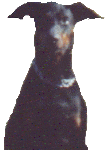A light-based
forewarning signal, consists of the pole
(painted in white or grey) the head, where two lights
(orange and green) are placed vertically. Sometimes
the conditions let setting the signal that has only
one cell (one light), if only two signals are needed
(orange and blinking orange).
The plate on the head indicates the name of the
semaphore, which is described by the forewarning
signal. For example if the forewarning signal
concerns the semaphore named 'A101', then 'ToA101' is
written on the plate on the forewarning signal. 'To'
letters mean forewarning signal (tarcza ostrzegawcza'
in Polish). As you see I made a mistake, because '3'
is not a name of the semaphore (letters are required)
:-)
The forewarning signal is not a semaphore, which
means it doesn't show you the signal that makes you
do something, but it only shows what kind of signal
is reflected on the semaphore.
The separate
forewarning signal concerns the rail-road crossing on
a high-speed main routes. It warns the loco-engineer
if the toll-bar is lowered or not.
The cancellation of
the forewarning signal is done by mounting the white
cross between the cells on the head.
A shape-based
forewarning signal (classic, mechanical)
consists of the pole and one huge orange
circle-shaped plate on it. This is the most common
used forewarning mechanical signal on which only two
positions can be set. Sometimes (very very very rare,
concerning the mechanical signals) the conditions
require use three possible signals, so then the
additional arrow (white, red-contoured) is placed
below the circle.
The circle can be moved to a horizontal position, and
the arrow can be rotated 45 degrees.
The signals given by the mechanical forewarning
'shield' are different depending on the daylight or
night. During the day the shape-signal is valid,
while during the night - light signal.
The cancellation of
the forewarning shape-based signal is done by
mounting the white cross on the orange circle.
If the forewarning
mechanical circle is placed together with the main
semaphore, the forewarning signal given by the circle
concerns the next main semaphore.



